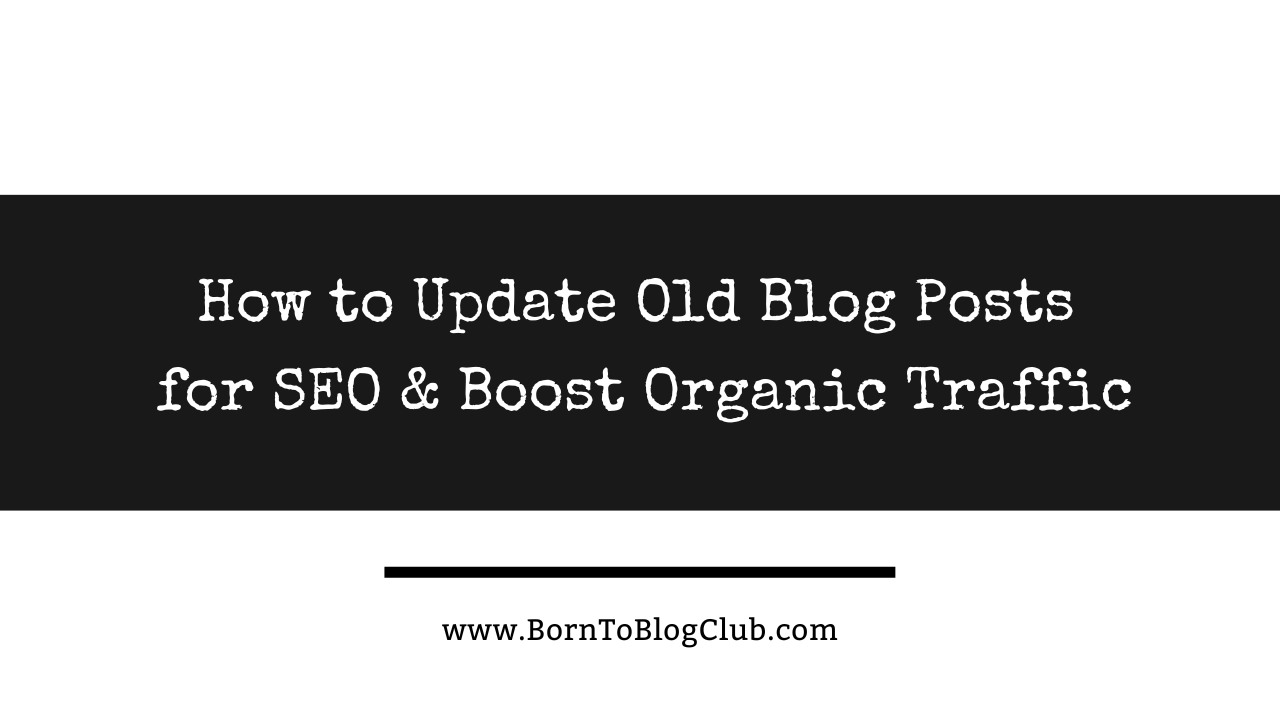If you’re looking to boost your organic traffic and improve SEO performance, updating old blog posts is one of the most effective strategies. A content refresh can breathe new life into outdated articles, enhancing both their relevance and visibility. In this guide, we’ll walk you through practical tips on how to update old blog posts for SEO, including how to optimize blog content, improve blog post rankings, and implement SEO content updates that align with current search trends. Whether you’re looking to refine your SEO content strategy, increase organic traffic, or simply refresh old content for better performance, this post has you covered with actionable advice to help your blog posts rank higher and drive more visitors.
Ways To Update Old Blog Posts for SEO & Boost Organic Traffic
1. Consolidate Mid-Performing Content
Not every blog post will perform exceptionally well on its own. If you have multiple posts on similar topics, consider consolidating them into a single, comprehensive post. This can help you create a powerhouse article, boosting its SEO and readability.
2. Update Heading Tags to Include the Current Year
Including the year in your headings can help signal to both users and search engines that your content is up-to-date. For example, “Best SEO Tips for 2025” makes it clear your content is current.
3. Refresh Meta Tags and Improve CTR
Update your meta titles and descriptions to improve click-through rates (CTR). Add relevant keywords that better match searcher intent, or incorporate action words that can entice users to click.
4. Answer “People Also Ask” Questions
Take advantage of Google’s “People Also Ask” section to find popular queries related to your blog’s topic. Integrate these questions and their answers directly into your content, improving relevance and potential search visibility.
5. Ensure Search Intent Alignment
Search intent is crucial for SEO. Revisit your content to ensure it matches user expectations. For example, if your post ranks for a “how-to” keyword, make sure it provides actionable steps and answers to common questions.
6. Add Internal Links to Recent Content
Linking to newer blog posts or pages within your website can help drive traffic to those pages while also keeping your content interconnected. This improves the user experience and boosts SEO.
7. Link to New Research or Studies
Stay relevant by linking to updated studies, new statistics, or recent research in your niche. This enhances the credibility of your content and provides additional value to readers.
8. Scan for and Remove Broken Links
Broken links negatively affect SEO and user experience. Use tools to identify any broken links and update or remove them.
9. Add Schema Markup
Implementing structured data through Schema markup helps search engines better understand your content. This can lead to rich snippets and improved rankings.
10. Adjust Formatting and Layout
Changing the layout and improving readability can make a huge difference. Use headings, bullet points, and short paragraphs to break up text and make it easier to read.
11. Take Inspiration from Competitors
Check out how your competitors are approaching similar topics. If they’re offering fresh insights or better visuals, consider updating your post to compete with them.
12. Research Industry Trends
Make sure your content reflects current trends in your industry. Doing so keeps your blog relevant and helps position it as a thought leader.
13. Optimize for Keywords You’re Already Ranking For
If your old post is already ranking for certain keywords, optimize it further by improving the content’s depth and incorporating semantically related keywords.
14. Target New Keywords
Alongside optimizing for existing keywords, look for opportunities to target new ones. Perform keyword research to identify relevant long-tail keywords that can drive additional traffic.
15. Incorporate Videos or Images
Multimedia elements like videos, infographics, or high-quality images can significantly enhance the user experience. They also help your content stand out in search results.
16. Update Product or App Photos
If your post features product reviews or app recommendations, refresh any outdated images with the latest photos. This is crucial for posts that highlight product features or specifications.
17. Revise Alt Text for SEO
Don’t forget to update the alt text for images. This not only helps with image SEO but also improves accessibility.
18. Set a Schedule for Regular Content Updates
To keep your blog posts performing well over time, set a routine for reviewing and updating old content. Regular updates can ensure that your content stays relevant.
19. Be Mindful of Drastic Changes
While it’s important to refresh old posts, avoid making drastic changes that might confuse existing readers. Keep the essence of the post intact while enhancing it for SEO.
20. Add Expert Quotes or Testimonials
Incorporating expert opinions or testimonials can help build authority and trust in your content. This also provides a fresh perspective for readers.
21. Keep the URL Consistent
If your post is already ranking, don’t change the URL. Altering it could result in a loss of SEO value and broken links. If necessary, set up a 301 redirect.
22. Remove Brand-Specific Mentions
If your content mentions brands or products that are no longer relevant or have changed, consider removing or updating those references. This ensures that your content remains evergreen.
23. Rewrite the Introduction
A compelling introduction can set the tone for the entire post. Rewrite your intro to make it more engaging, relevant, and aligned with your target audience’s needs.
24. Treat Old Content as New Content
Don’t just “update” it – treat it as a brand-new post by adding significant value. This can mean enhancing the overall structure, adding new sections, or offering a fresh viewpoint.
25. Repromote Your Updated Post
Once your post is refreshed, don’t forget to promote it again. Share it on social media, send it out in newsletters, and link to it from newer posts.
Final Thoughts…
Updating old blog posts is a vital part of any SEO strategy. Not only does it improve the performance of your existing content, but it also boosts your credibility and keeps your audience engaged. By applying the above tips, you can enhance the SEO of your old blog posts and watch your organic traffic grow.
Please leave a comment below and Let me know your thoughts on this post.
Don’t Miss A Thing…
Follow @BornToBlogClub on your favorite social media platforms via: Pinterest, Facebook, Instagram, Twitter X, LinkedIn, TikTok, YouTube and Don’t forget to Sign Up for the FREE B2B NEWSLETTER!
ABOUT ME:
If we haven’t officially met, Hi I’m Blogging Brandi an EX-Corp Kool-Aid Drinker, born to be a blogger, Creator, and Entrepreneur! I also have a Degree in Finance and am a Licensed Cosmetologist. Plus, I LOVE RVing and hanging out with my Dogs ( I have a Cat too!)…
Affiliate Disclaimer: Note this description contains affiliate links that allow you to find the items mentioned in this video and support the channel at no cost to you. While this channel may earn minimal sums when the viewer uses the links, the viewer is in no way obligated to use these links. Thank you for your support!

If we haven’t officially met, Hi I’m Blogging Brandi an EX-Corp Kool-Aid Drinker, born to be a blogger, Creator, and Entrepreneur! I also have a Degree in Finance and am a Licensed Cosmetologist. Plus, I LOVE RVing and hanging out with my Dogs ( I have a Cat too!)…
